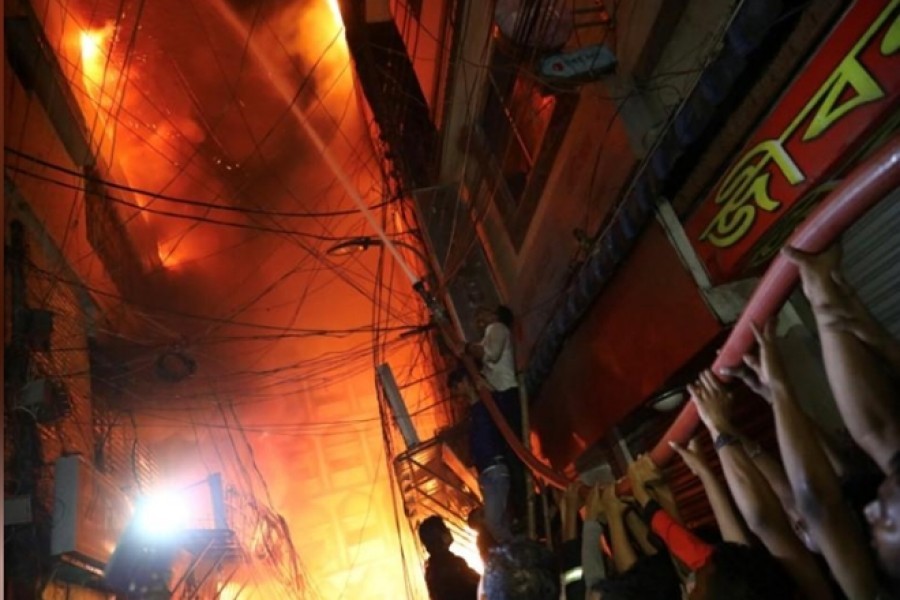The two consecutive fires, both massive and deadly, that recently broke out in Dhaka evidently point to an insidious social malady. It mainly comprises apathy and improvisation involving the problems and scourges of Dhaka's urban life. As a consequence, problems keep accumulating, with small failures to address a potential hazard snowballing into critical situations. The recent blazes in the capital and some other man-made disasters have long been making inroads into the community and individual lives. To take a broader angle, these maladies do not remain confined to the capital only. Veritably the whole country has been afflicted with the menaces of dodging responsibility, procrastination, blatant disregard for law and lots of other lapses. It doesn't take longer for the fallout to affect the errant people. Scores of innocent persons also become victims for no fault of theirs.
Since the capital continuously remains in national focus, abnormalities occurring there spread to the nearby areas and, finally, throughout the country. Bad practices affect people faster than the good and better ones. The trend applies to today's Bangladesh quite appropriately. In most cases urban scourges are normally seen beginning from the capital. In fact, the whole city is now almost devoured by myriad practices and propensities that prompt a large section of people to behave in deviant ways. At times, the cases of indulgence in irregularities and aberrations reach alarming peaks. This is when the cynics might feel like quoting Shakespeare with a twist, "Something is rotten in the city of Dhaka." Of course, it is. Ranging from the chaotic and recklessly used roads, the vehicle operators' perverse bent of mind, tragic deaths to harassment and humiliation of women and girls --- the city at the moment appears to be a phase of decadence incarnate. Few areas, including education, healthcare to a cohesive community life, are completely free of maladies and malaises. Distressingly, these abnormalities continue to be replicated in every part of the county.
Let us turn to the deviant ways persistently in place in Dhaka's social landscape. Given the ever-rising frenzy to join all imaginable types of wrong-doings and misdeeds, even an incisive depiction of the city scenario might seem incomplete. The real picture is awfully grimmer and more hostile. According to the long-time residents of Dhaka, the city has not deteriorated to this nearly incorrigible point in a day or two. Against the backdrop of recurring blazes, many pertinent questions arise. They remain focused on not abiding by laws and adoption of short-cut measures. Decades of ad hoc measures and indifference on the part of the authorities, flouting of rules and regulations by the building owners, and taking recourse to irregularities as a whole have added to the fast deterioration in the construction sector. The cases of two devastating fires emerge as ready references. The fire at Chawkbazar on February 20 was mainly caused by the nonchalance of the authorities on the illegal practice of setting up chemical factories in a residential area and the storage of hazardous combustibles in multi-storey residential buildings. The giant blaze has followed a similar chemical-induced fire that killed 123 in 2010. Like the later one, that blaze also broke out in the older part of the capital --- at Nimtoli. That corrupt practices tempt all gullible people irrespective of social classes has been demonstrated by the Banani fire on March 29. Unlike the illegal chemical hoarders and factory owners at Nimtoli, Banani's FR Tower has long been occupied by relatively upscale commercial enterprises. The building authorities and the persons using it were expected to be aware of the imperative of preventions against accidental blazes. Unfortunately, they were not. Building codes related to the minimum height of the high-rise were flouted. The structure was supposed to have 18 floors. Instead it rose to 23 levels. Moreover, the FR Tower did not have emergency fire exits with adequate width. There were other drawbacks, too. The authorities have allegedly overlooked them.
Following the Banani blaze, the Department of Fire Service and Civil Defence came up with a terrible revelation. According to it, only 129 out of the 3,786 concrete structures surveyed by it in 2017 were not identified as 'risky' or 'extremely risky'. To call the finding just frightening is gross understatement. In fact, the situation totters on the verge of becoming a colossal urban disaster. Urban experts apprehend a great Dhaka-wide inferno in the wake of a major earthquake. A city witnessing mushrooming growth of multi-storey buildings all over it, one touching another's wall, is feared to turn into a fireball following dreadful jolts. Moreover, buildings continue to collapse or cave in for being built without following the approved plans. The catastrophic consequences awaiting them after earthquakes are understood. During normal times, the periodic flare-up of great localised fires, like that in Gulshan on March 30 or the slum fires, are now commonplace in the capital. Given all these depressing scenarios, Dhaka stands out as a city of nightmares.


